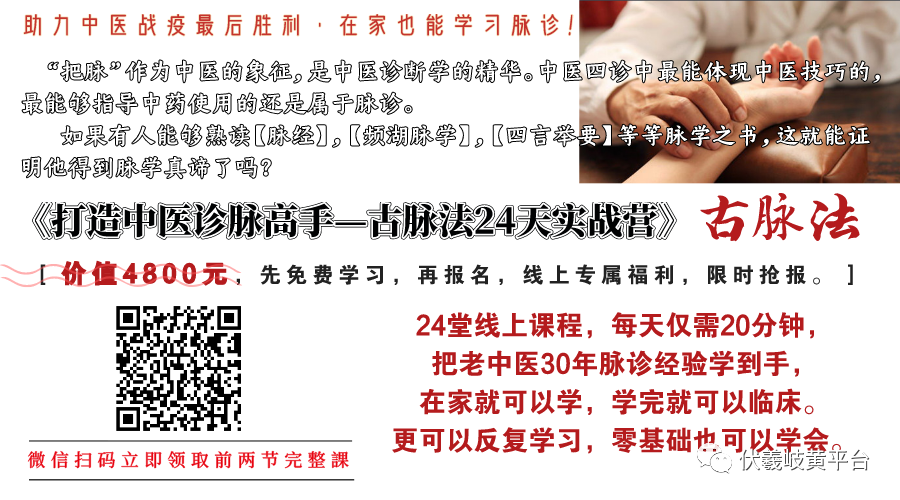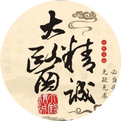1. Analysis of the 28 Pulses (Independent Pulse Patterns)
① Pulse patterns primarily characterized by abnormal pulse positions — Fu (Floating), Ru (Soft), Qiao (Soggy), Ge (Leather), Chen (Deep), Fu (Hidden), Lao (Firm), Duan (Short), Chang (Long)
Concept of “abnormal pulse position”: refers to changes in the position of the pulse body, such as vertical or horizontal shifts.
Examples:
1) Fu (Floating) Pulse: Characteristics — easily felt with light pressure, insufficient with heavy pressure. Indicates exterior syndrome, deficiency syndrome.
2) Ru (Soft) Pulse: Characteristics — floating and fine, does not withstand heavy pressure, not evident with heavy pressure. Indicates deficiency syndrome, dampness syndrome.
Analysis of Ru Pulse: The pulse is superficial, easily felt with light pressure, insufficient with heavy pressure; the pulse body is thin like a thread; the pulse vessel has weak elasticity.
3) Chen (Deep) Pulse: Characteristics — not felt with light pressure, felt with heavy pressure. Indicates interior syndrome.
Analysis of Chen Pulse: The pulse is located deep, cannot be felt with light or moderate pressure, only with heavy pressure.
4) Duan (Short) Pulse: Characteristics — both ends are short, cannot fill the area. Indicates qi deficiency.
Analysis of Duan Pulse: Pulsation is only evident at the Guan position, unclear or not evident at the Cun and Chi positions.
5) Chang (Long) Pulse: Characteristics — both ends are straight, exceeding the normal position. Indicates a long and strong pulse is due to excess pathogenic qi. A long and soft pulse is a normal pulse.
Analysis of Chang Pulse: The pulse vessel extends beyond the Cun, Guan, and Chi positions, with a long and straight pulse body.
6) Qiao (Soggy) Pulse: Characteristics — floating, large, and hollow, like pressing on a scallion tube. Indicates blood loss, yin injury.
Analysis of Qiao Pulse: The pulse is floating, easily felt with light pressure; the pulse shape shows vessels on both sides, but is hollow in the middle.
7) Ge (Leather) Pulse: Characteristics — floating and broad, hollow inside but firm outside, like pressing on a drum skin. Indicates severe deficiency of essence and blood, yang qi floating outward.
Analysis of Ge Pulse: The pulse is floating, easily felt with light pressure; the outer layer of the pulse vessel is hard but hollow inside, not responding to pressure; the entire pulse vessel feels like pressing on a drum skin.
8) Fu (Hidden) Pulse: Characteristics — requires heavy pressure to feel, may be hidden and not felt; deeper than the Chen pulse. Indicates closed pathogenic factors; syncope; extreme pain.
Analysis of Fu Pulse: Requires significant pressure to feel the pulse, may still be difficult to detect.
9) Lao (Firm) Pulse: Characteristics — combines features of deep, wiry, full, large, and long pulses, firm and unyielding. Indicates internal cold and fullness; hernia symptoms.
Analysis of Lao Pulse: Analysis includes deep pulse, wiry pulse, full pulse, long pulse. The “large pulse” indicates a wide pulse body, but the pulse force is not surging.
② Pulse patterns primarily characterized by abnormal pulse rates — Shu (Rapid), Ji (Hasty), Chi (Slow), Huan (Leisurely)
Concept of “abnormal pulse rate”: refers to the pulse rate exceeding or falling below normal within a minute. Examples:
10) Shu (Rapid) Pulse: Characteristics — rapid pulse rate, 90-139 beats/minute (5 or more beats per breath), regular rhythm. Indicates heat syndrome. (“One breath” refers to the time of one inhalation and exhalation of a normal person.)
11) Chi (Slow) Pulse: Characteristics — slow pulse, less than 4 beats per breath, regular rhythm. Indicates cold syndrome.
12) Ji (Hasty) Pulse: Characteristics — urgent and rapid pulse, 7-8 beats per breath (over 140 beats/minute). Indicates yang counteracting yin, vital energy about to collapse.
13) Huan (Leisurely) Pulse: Characteristics — 4 beats per breath, slow and relaxed pulse shape, lacking sufficient tension; pulse rate slightly slower than normal but faster than slow pulse, indicates dampness syndrome; spleen and stomach deficiency; after prolonged illness and treatment, indicates recovery of righteous qi.
③ Pulse patterns primarily characterized by abnormal pulse rhythms — Cu (Intermittent), Jie (Knotted), Dai (Regularly Intermittent).
Concept of “abnormal pulse rhythm”: refers to irregular pulse rhythm. Examples:
14) Cu (Intermittent) Pulse: Characteristics — rapid and irregular, with intermittent pauses. Indicates excessive yang heat.
Analysis of Cu Pulse: Rapid pulse rate, greater than 90 beats/minute, with irregular pauses.
15) Jie (Knotted) Pulse: Characteristics — slow pulse with occasional stops, with no fixed number of stops. Indicates excess yin, qi stagnation, cold phlegm, blood stasis, accumulation of food, etc.
Analysis of Jie Pulse: Slow pulse with irregular pauses, pulse rate less than or equal to 90 beats/minute, with irregular rhythm.
16) Dai (Regularly Intermittent) Pulse: Characteristics — pulse comes to a stop, with a fixed number of stops, returning after a long time. Indicates weak organ qi, pain, fright, trauma.
Analysis of Dai Pulse: Normal pulse rate, 60-90 beats/minute. Regular pauses in rhythm.
④ Pulse patterns primarily characterized by abnormal pulse shapes — Hong (Surging), Xi (Thin), Hua (Slippery), Se (Rough), Xian (Wiry), Jin (Tight).
Concept of “abnormal pulse shape”: refers to the abnormal sensation of the pulse during pulsation, including amplitude and speed of rise and fall, surface smoothness, elasticity, volume, and area under the fingers.
Examples:
17) Hong (Surging) Pulse: Characteristics — wide pulse body, resembling a flood, strong on arrival and weak on departure. Indicates excessive yang heat, residual yang escaping.
Analysis of Hong Pulse: Wide pulse body; large amplitude; rapid rise and fall like “coming with great force and leaving with diminished force”; pulse is strong and not weak.
18) Xi (Thin) Pulse: Characteristics — thin pulse body, resembling a thread, clearly felt under the fingers. Indicates deficiency syndrome, dampness syndrome.
Analysis of Xi Pulse: When pulsating, the pulse feels thin like a thread, with a fine line sensation.
19) Hua (Slippery) Pulse: Characteristics — smooth and flowing pulse, like beads rolling, feels round under the fingers. Indicates phlegm syndrome, food accumulation, excess heat syndrome (also seen in normal individuals and pregnant women).
Analysis of Hua Pulse: When pulsating, the pulse feels smooth and flowing, with a sensation of rapid movement, surface smooth.
20) Se (Rough) Pulse: Characteristics — difficult to come and go, feels rough under the fingers (opposite of slippery pulse), like “a light knife scraping bamboo.” Indicates rough and strong for excess syndrome, blood stasis, food accumulation, phlegm obstruction; rough and weak for essence injury, blood deficiency.
Analysis of Se Pulse: When pulsating, the pulse lacks smoothness, flowing with difficulty, surface feels like fine serrations.
21) Xian (Wiry) Pulse: Characteristics — straight and long, like pressing on a guitar string. Indicates liver and gallbladder disease, pain, phlegm fluid, malaria.
Analysis of Xian Pulse: The pulse vessel is long and straight; under the fingers, it feels like a guitar string, with slightly higher tension.
22) Jin (Tight) Pulse: Characteristics — tense pulse, resembling a twisted rope. Indicates cold syndrome, pain syndrome, food stagnation in the gastrointestinal tract.
Analysis of Jin Pulse: The pulse body has high tension, with a sensation of rotation under the fingers, pulse feels strong.
23) Dong (Moving) Pulse: Characteristics — pulse shape like a bean, slippery, rapid, and short, especially evident at the Guan position. Indicates pain syndrome, fright.
Analysis of Dong Pulse: The pulsation is mainly felt in one area, often at the Guan position (i.e., short); surface smooth, rapid (i.e., slippery); pulsation feels like a bean jumping.
⑤ Pulse patterns primarily characterized by abnormal pulse strength — Shi (Full), Xu (Deficient), Ruo (Weak), Wei (Minute), San (Scattered).
Concept of “abnormal pulse strength”: refers to changes in the force and strength of the pulse.
24) Shi (Full) Pulse: Characteristics — strong and full at the Cun, Guan, and Chi positions. Indicates excess syndrome.
Analysis of Shi Pulse: The pulse body is long and large, with a full sensation, strong pulse force at the Cun, Guan, and Chi positions.
25) Xu (Deficient) Pulse: Characteristics — feels empty and weak during pulsation. Indicates deficiency syndrome.
Analysis of Xu Pulse: The pulse force is weak, with an empty sensation; cannot be felt with light, moderate, or heavy pressure.
26) Ruo (Weak) Pulse: Characteristics — extremely fine and soft. Indicates deficiency of qi and blood; yang deficiency.
Analysis of Ruo Pulse: The pulse is located deep (i.e., Chen pulse), feels fine like a thread during pulsation (i.e., Xi pulse); the pulse elasticity is soft; the pulse force is extremely weak.
27) Wei (Minute) Pulse: Characteristics — very small pulse shape, weak pulse strength, almost imperceptible. Indicates severe deficiency of qi and blood; weak yang qi.
Analysis of Wei Pulse: The pulse feels like a fine line, lacking strength and energy, almost imperceptible.
28) San (Scattered) Pulse: Characteristics — floating and scattered, without root, barely felt with pressure, irregular in number. Indicates pulse is floating (i.e., easily felt with light pressure), but with slight pressure, the pulse cannot be felt; the pulse rate is irregular, varying within different “breaths”.
2. Strange Pulses: Includes critical pulse patterns, often seen in heart disease, heart failure, arrhythmia, such as Fu Bo (Boiling Pot Pulse), Wu Lou (Leaky Roof Pulse), Que Zhuo (Sparrow Pecking Pulse), Jie Suo (Tight Knot Pulse), Yu Xiang (Fish Flying Pulse), Xia You (Shrimp Swimming Pulse), Tan Shi (Stone Bouncing Pulse).
3. Combined Pulses
① Concept of “combined pulses”: Combined pulses refer to independently named pulse patterns that appear together, such as: floating tight, floating leisurely, floating rapid, floating slippery, deep slow, wiry rapid, slippery rapid, surging rapid, deep wiry, deep rough, wiry thin, deep leisurely, deep thin, wiry slippery, etc.
② Main diseases of combined pulses: A synthesis of the main diseases of each pulse. For example: floating rapid = floating pulse + rapid pulse, indicating exterior heat.

|
I Copyright Statement: Respect knowledge and labor, please retain copyright information when reprinting. The copyright of the content published on this platform belongs to the relevant rights holders. If there is any improper use, please feel free to contact us for negotiation. I Submission and Cooperation Email: [email protected] |
Currently, over 100,000 people have followed and joined us.













See more latest information on Traditional Chinese Medicine, Chinese herbs, hygiene, and health.
Please long press the QR code below to follow us.


Traditional Chinese Medicine | Development | Cooperation | Sharing | Public Welfare | Platform

↓Fuxi Qihuang Platform, Service Number QR Code↓



↓Fuxi Qihuang Platform, Online Learning Entrance↓


